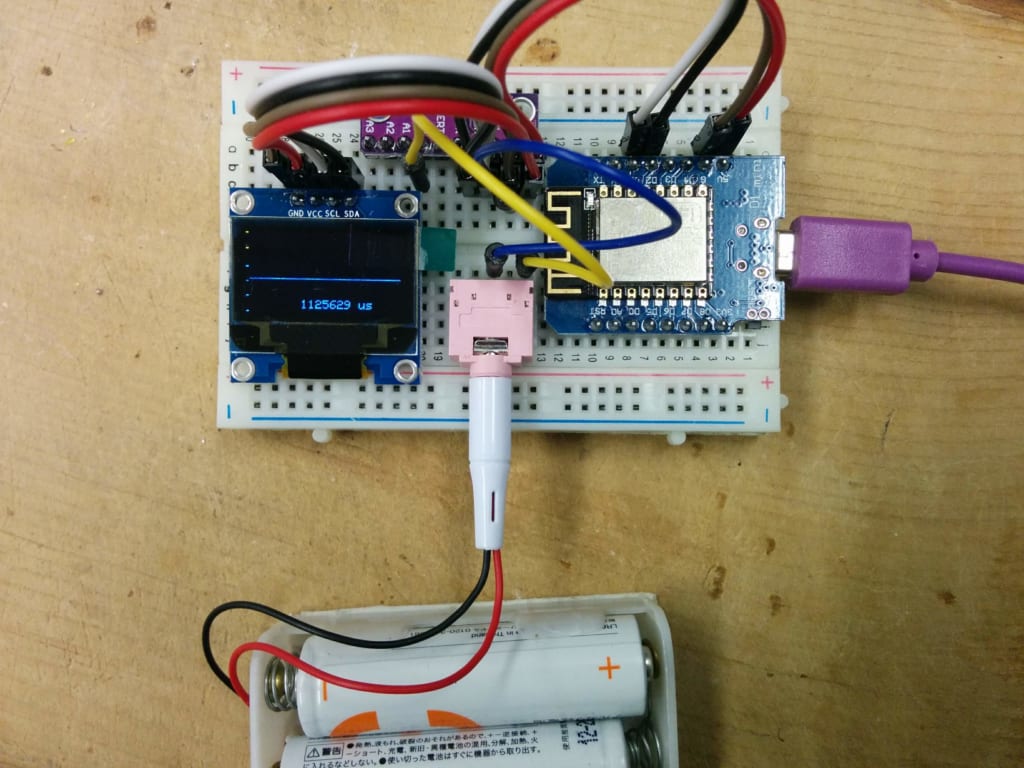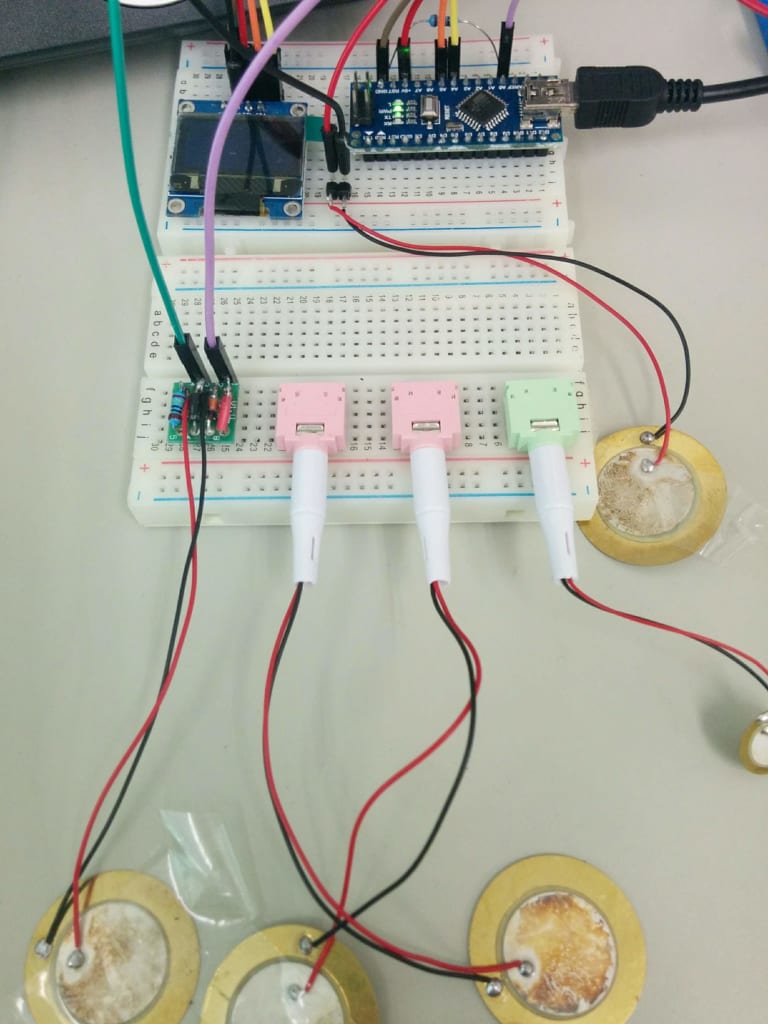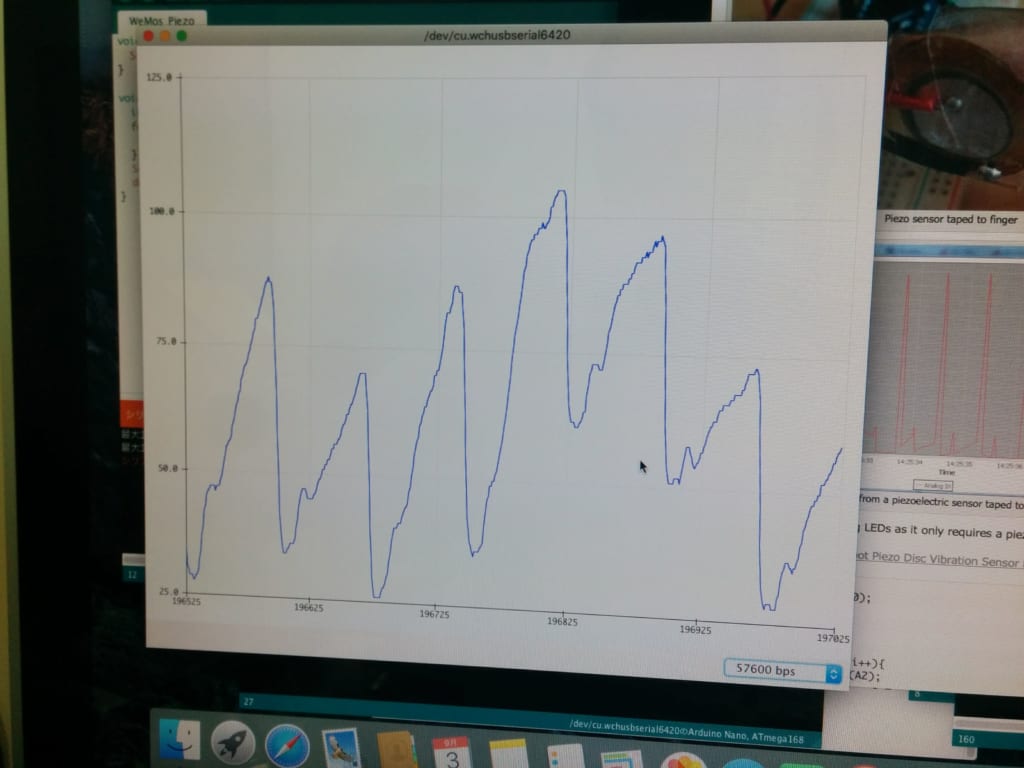前回WeMos (b9) ADS1115 for A/Dで数値の表示ができたが、Oscilloscopeのような表示すべく、改造を試み。
しかし、2月から、WeMos miniの開発中も頻繁にリブートしています。デバイストライバのバージョンを変えたり、OSを変えたりしても改善しない。

そのため、このプログラムは未完成のまま放置。
/*
This is set up to use a 128x64 I2C screen, as available
here: http://www.banggood.com/buy/0-96-oled.html
For wiring details see http://youtu.be/XHDNXXhg3Hg
*/
#include <SPI.h>
#include <Wire.h>
#include <limits.h>
#include <Adafruit_GFX.h>
#include <Adafruit_SSD1306.h>
#include <Adafruit_ADS1015.h>
#include <math.h>
#define WINDOW_SIZE 128
Adafruit_ADS1115 ads; /* Use this for the 16-bit version */
//Adafruit_ADS1015 ads; /* Use thi for the 12-bit version */
#define OLED_RESET 0 // 4
Adafruit_SSD1306 display(OLED_RESET);
#if (SSD1306_LCDHEIGHT != 64)
// error("Height incorrect, please fix Adafruit_SSD1306.h!");
#endif
/********************************************/
#define CHARWIDTH 5
#define CHARHEIGHT 8
#define AXISWIDTH (2 + 1) // axis will show two-pixel wide graph ticks, then an empty column
#define VISIBLEVALUEPIXELS (128 - AXISWIDTH) // the number of samples visible on screen
#define NUMVALUES (2 * VISIBLEVALUEPIXELS) // the total number of samples (take twice as many as visible, to help find trigger point
#define TRIGGER_ENABLE_PIN D6 // 2 set this pin high to enable trigger
#define SCREEN_UPDATE_ENABLE_PIN D8 // 3 set this pin high to freeze screen
byte values[NUMVALUES]; // stores read analog values mapped to 0-63
int pos = 0; // the next position in the value array to read
int count = 0; // the total number of times through the loop
unsigned long readStartTime = 0; // time when the current sampling started
int sampleRate = 1; // A value of 1 will sample every time through the loop, 5 will sample every fifth time etc.
// Draws the graph ticks for the vertical axis
void drawAxis()
{
// graph ticks
for (int x = 0; x < 2; x++) {
display.drawPixel(x, 0, WHITE);
display.drawPixel(x, 13, WHITE);
display.drawPixel(x, 26, WHITE);
display.drawPixel(x, 38, WHITE);
display.drawPixel(x, 50, WHITE);
display.drawPixel(x, 63, WHITE);
}
}
// Draws the sampled values
void drawValues()
{
int start = 0;
if ( digitalRead(TRIGGER_ENABLE_PIN) ) {
// Find the first occurence of zero
for (int i = 0; i < NUMVALUES; i++) {
if ( values[i] == 0 ) {
// Now find the next value that is not zero
for (; i < NUMVALUES; i++) {
if ( values[i] != 0 ) {
start = i;
break;
}
}
break;
}
}
// If the trigger point is not within half of our values, we will
// not have enough sample points to show the wave correctly
if ( start >= VISIBLEVALUEPIXELS )
return;
}
for (int i = 0; i < VISIBLEVALUEPIXELS; i++) {
display.drawPixel(i + AXISWIDTH, 63 - (values[i + start]), WHITE);
}
}
// Shows the time taken to sample the values shown on screen
void drawFrameTime(unsigned long us)
{
display.setCursor(9 * CHARWIDTH, 7 * CHARHEIGHT - 2); // almost at bottom, approximately centered
display.print(us);
display.println(" us");
}
/********************************************/
void setup() {
// The ADC input range (or gain) can be changed via the following
// functions, but be careful never to exceed VDD +0.3V max, or to
// exceed the upper and lower limits if you adjust the input range!
// Setting these values incorrectly may destroy your ADC!
// ADS1015 ADS1115
// ------- -------
ads.setGain(GAIN_TWOTHIRDS); // 2/3x gain +/- 6.144V 1 bit = 3mV 0.1875mV (default)
// ads.setGain(GAIN_ONE); // 1x gain +/- 4.096V 1 bit = 2mV 0.125mV
// ads.setGain(GAIN_TWO); // 2x gain +/- 2.048V 1 bit = 1mV 0.0625mV
// ads.setGain(GAIN_FOUR); // 4x gain +/- 1.024V 1 bit = 0.5mV 0.03125mV
// ads.setGain(GAIN_EIGHT); // 8x gain +/- 0.512V 1 bit = 0.25mV 0.015625mV
// ads.setGain(GAIN_SIXTEEN); // 16x gain +/- 0.256V 1 bit = 0.125mV 0.0078125mV
ads.begin();
// Set up the display
display.begin(SSD1306_SWITCHCAPVCC, 0x3C); // Initialize with the I2C addr 0x3D (for the 128x64)
display.setTextColor(WHITE);
pinMode(TRIGGER_ENABLE_PIN, INPUT);
pinMode(SCREEN_UPDATE_ENABLE_PIN, INPUT);
}
/********************************************/
void loop() {
// If a sampling run is about to start, record the start time
if ( pos == 0 )
readStartTime = micros();
// If this iteration is one we want a sample for, take the sample
if ( (++count) % sampleRate == 0 )
values[pos++] = (ads.readADC_SingleEnded(0)>> 7) / 3; // shifting right by 4 efficiently maps 0-1023 range to 0-63
// values[pos++] = analogRead(0) >> 4; // shifting right by 4 efficiently maps 0-1023 range to 0-63
// If we have filled the sample buffer, display the results on screen
if ( pos >= NUMVALUES ) {
// Measure how long the run took
unsigned long totalSampleTime = (micros() - readStartTime) / 2; // Divide by 2 because we are taking twice as many samples as are shown on the screen
if ( !digitalRead(SCREEN_UPDATE_ENABLE_PIN) ) {
// Display the data on screen
display.clearDisplay();
drawAxis();
drawValues();
drawFrameTime(totalSampleTime);
display.display();
}
// Reset values for the next sampling run
pos = 0;
count = 0;
}
}




